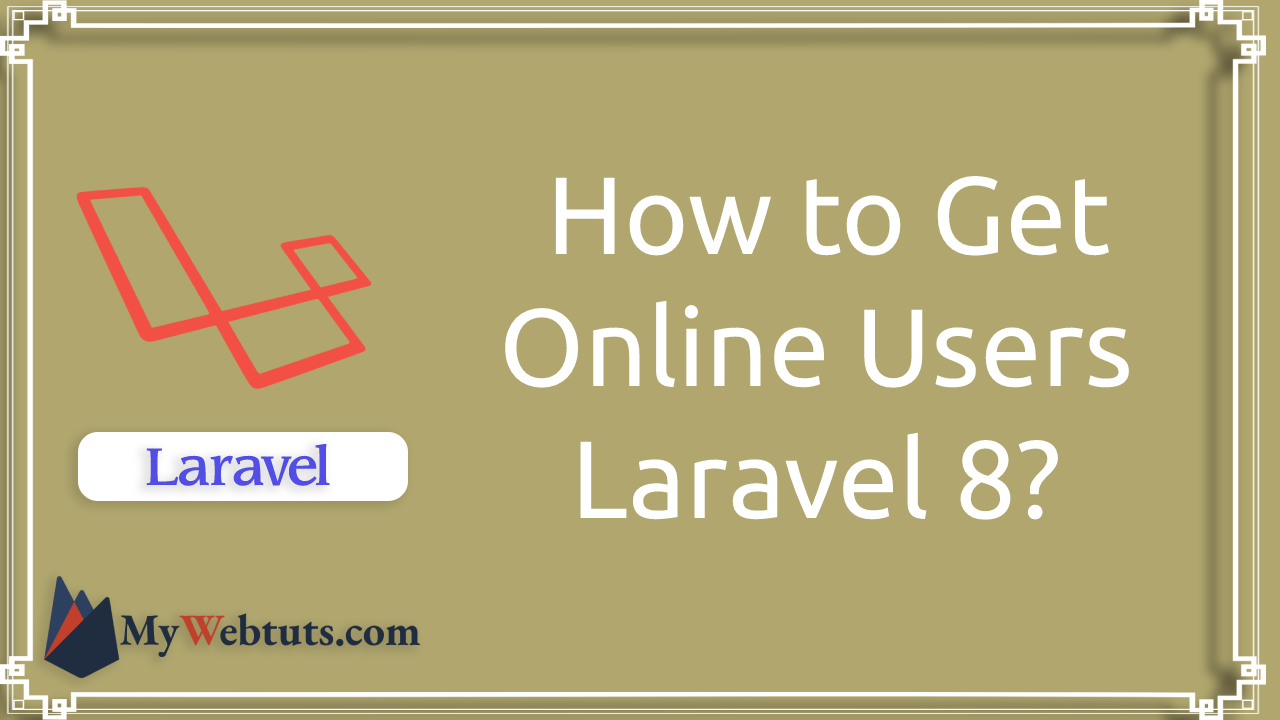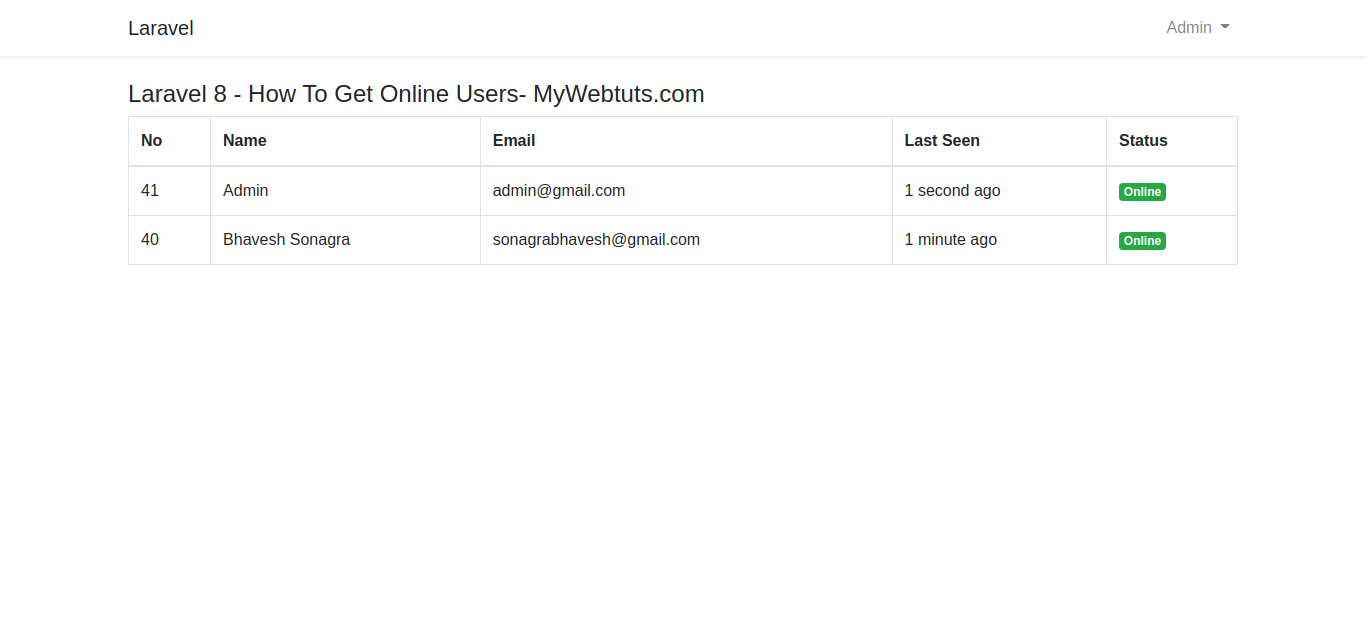How to Get Online Users Laravel 8?
Oct 20, 2021 . Admin

Hey Artisan,
Today, I will justify to you how can check online users in laravel 8 application. So we can easily check the laravel check if a user is online or not. I will learn about how to recognize a user is online or not and store last seen data.
So, we will integrate the new column "last_seen" in the users table and create new middleware for a web that will check if the user login then it will update the last_seen time and add the key for online in the cache, so we can check user online or not using that. so just follow below steps.
Here, I will give you a full example of how can check laravel to get all logged-in users in laravel 8 so follow my all steps.
Step 1 : Install Laravel AppIn this step, You can install laravel fresh app. So open a terminal and put the bellow command.
composer create-project --prefer-dist laravel/laravel StatusStep 2 : Setup Database Configuration
After successfully install laravel app thenafter configure databse setup. We will open ".env" file and change the database name, username and password in the env file.
DB_CONNECTION=mysql DB_HOST=127.0.0.1 DB_PORT=3306 DB_DATABASE=Enter_Your_Database_Name DB_USERNAME=Enter_Your_Database_Username DB_PASSWORD=Enter_Your_Database_PasswordStep 3 : Create Auth using scaffold
Now, in this step, we will create auth scaffold command to create login, register and dashboard. so run following commands:
composer require laravel/ui
After, that you can run following command and check ui commands info.
php artisan ui --help
Next, You can use the following commands for creating auth:
Using Bootstrap:
php artisan ui bootstrap --auth
npm install
npm run devStep 4 : Add Column in User Table
So after the next step You can add a column in the user table So Let's Open the terminal and run the bellow command:
php artisan make:migration add_last_seen_to_users_table --table=users
Run successfully above command after adding column into the user table. open migration file and put below code.
<?php
use Illuminate\Database\Migrations\Migration;
use Illuminate\Database\Schema\Blueprint;
use Illuminate\Support\Facades\Schema;
class AddLastSeenToUsersTable extends Migration
{
/**
* Run the migrations.
*
* @return void
*/
public function up()
{
Schema::table('users', function (Blueprint $table) {
$table->timestamp('last_seen')->nullable();
});
}
/**
* Reverse the migrations.
*
* @return void
*/
public function down()
{
Schema::table('users', function (Blueprint $table) {
$table->timestamp('last_seen');
});
}
}
Put above code after run bellow command.
php artian migrate
Now,we will add this "last_seen" in User model.
Path: app/Models/User.php
<?php
namespace App\Models;
use Illuminate\Contracts\Auth\MustVerifyEmail;
use Illuminate\Database\Eloquent\Factories\HasFactory;
use Illuminate\Foundation\Auth\User as Authenticatable;
use Illuminate\Notifications\Notifiable;
class User extends Authenticatable
{
use HasFactory, Notifiable;
/**
* The attributes that are mass assignable.
*
* @var array
*/
protected $fillable = [
'name', 'email', 'password', 'last_seen'
];
/**
* The attributes that should be hidden for arrays.
*
* @var array
*/
protected $hidden = [
'password', 'remember_token',
];
/**
* The attributes that should be cast to native types.
*
* @var array
*/
protected $casts = [
'email_verified_at' => 'datetime',
];
}
Step 5 : Create Middleware
After successfully run migration next step we needed to create custom middleware as UserActivity using bellow command.
php artisan make:middleware UserActivity
Now open the middleware UserActivity.php file and paste bellow code in middleware file:
Path : app/http/middleware/UserActivity.php
<?php
namespace App\Http\Middleware;
use Closure;
use Illuminate\Http\Request;
use App\Models\User;
use Auth;
use Cache;
class UserActivity
{
/**
* Handle an incoming request.
*
* @param \Illuminate\Http\Request $request
* @param \Closure $next
* @return mixed
*/
public function handle(Request $request, Closure $next)
{
if (Auth::check()) {
$expire = now()->addMinutes(2); /* keep online for 2 min */
Cache::put('user-is-online-' .Auth::user()->id,true,$expire);
/* last seen */
User::where('id',Auth::user()->id)->update(['last_seen' => now()]);
}
return $next($request);
}
}
Step 6 : Add Middleware in Kernel File
In this step We have to add middleware to kernel file.Open kernel.php file and add middleware.
Path : app/http/kernel.php
protected $middlewareGroups = [
'web' => [
\App\Http\Middleware\EncryptCookies::class,
\Illuminate\Cookie\Middleware\AddQueuedCookiesToResponse::class,
\Illuminate\Session\Middleware\StartSession::class,
// \Illuminate\Session\Middleware\AuthenticateSession::class,
\Illuminate\View\Middleware\ShareErrorsFromSession::class,
\App\Http\Middleware\VerifyCsrfToken::class,
\Illuminate\Routing\Middleware\SubstituteBindings::class,
\App\Http\Middleware\UserActivity::class,
],
'api' => [
'throttle:api',
\Illuminate\Routing\Middleware\SubstituteBindings::class,
],
];
Step 7 : Add Route
In this step We have to add new route in route file Open web.php file add new route.
Path : routes/web.php
<?php
use Illuminate\Support\Facades\Route;
use App\Http\Controllers\UserController;
/*
|--------------------------------------------------------------------------
| Web Routes
|--------------------------------------------------------------------------
|
| Here is where you can register web routes for your application. These
| routes are loaded by the RouteServiceProvider within a group which
| contains the "web" middleware group. Now create something great!
|
*/
Route::get('online-user', [UserController::class, 'index']);
Step 8 : Create Controller
In this step, we should need create new controller as UserController. So put bellow code.
Path : app/http/controller/UserController.php
<?php
namespace App\Http\Controllers;
use Illuminate\Http\Request;
use App\Models\User;
class UserController extends Controller
{
/**
* Write Your Code..
*
* @return string
*/
public function index()
{
$users = User::select('*')
->whereNotNull('last_seen')
->orderBy('last_seen','DESC')
->paginate(10);
return view('users', compact('users'));
}
}
Step 9 : Create View File
In this step, we should create blade file as users.blade.php and paste the bellow code into blade file.
Path : resources/views/users.blade.php
@extends('layouts.app')
@section('content')
<div class="container">
<h4>Laravel 8 - How To Get Online Users- MyWebtuts.com</h4>
<table class="table table-bordered data-table">
<thead>
<tr>
<th>No</th>
<th>Name</th>
<th>Email</th>
<th>Last Seen</th>
<th>Status</th>
</tr>
</thead>
<tbody>
@foreach($users as $user)
<tr>
<td>{{ $user->id }}</td>
<td>{{ $user->name }}</td>
<td>{{ $user->email }}</td>
<td>
{{ Carbon\Carbon::parse($user->last_seen)->diffForHumans() }}
</td>
<td>
@if(Cache::has('user-is-online-' . $user->id))
<span class="badge badge-success">Online</span>
@else
<span class="badge badge-danger">Offline</span>
@endif
</td>
</tr>
@endforeach
</tbody>
</table>
</div>
@endsection
Now we are ready to run our example so run bellow command for quick run:
php artisan serve
Now you can open bellow URL on your browser:
http://localhost:8000/online-userOutput

It will help you...
